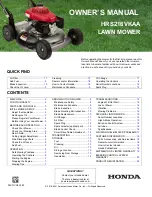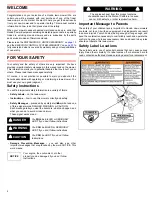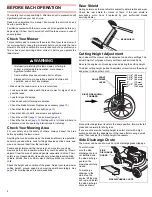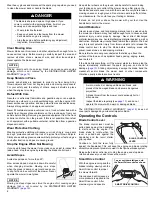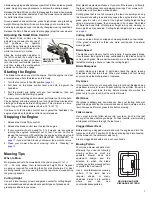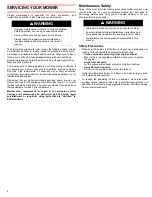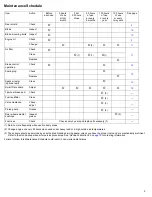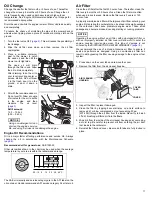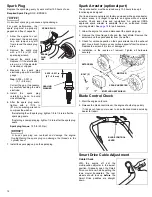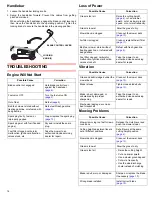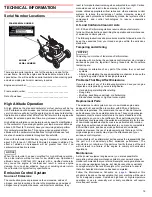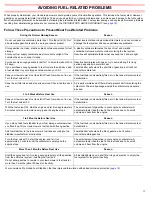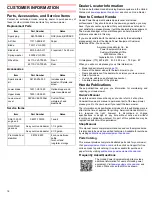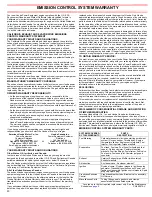
7
obtained, applying additional pressure will not further increase ground
speed. Apply only enough pressure to achieve the desired speed.
Release the Smart Drive control to disengage the drive when mowing
around trees and other obstacles. Push the mower around obstacles
for better directional control.
Ground speed varies with terrain, grass height, slope, and grass bag
weight. Moving the Smart Drive control allows you to maintain the
desired ground speed under constantly changing mowing conditions.
Release the Smart Drive control to disengage (stop) the rear wheels.
Adjusting the Smart Drive Control
The Smart Drive control can be
adjusted up or down into any one of
five positions for operator
comfort.Do not attempt to adjust the
position of the Smart Drive control
while the mower is in motion.
Slide the multi-position adjuster to
the left to unlock the control, move
the Smart Drive control up or down
into the most comfortable position,
and then release the multi-position
adjuster and allow it to engage.
Starting the Engine
The blade turns when you start the engine. Start the engine in a clear
or mowed area where the blade can turn freely.
1. Turn the fuel valve to the ON position (
2. Pull back on the blade control lever and hold it against the
handlebar.
3. Pull the starter grip lightly until you feel resistance, then pull
briskly. Return the starter grip gently.
To ensure easy restarting and maximum performance from the Auto
Choke System, allow the engine to run for at least three minutes after
starting a cold engine before shutting down. This minimum run time
will be longer if the temperature is below 70 °F (21 °C).
Continue to hold the blade control lever against the handlebar; the
engine stops when the blade control lever is released.
Stopping the Engine
1. Release the Smart Drive control.
2. Release the blade control lever to stop the engine.
3. If your mower will not be used for 3 to 4 weeks, we recommend
running the engine’s carburetor out of fuel. You can do this by
leaving the fuel valve OFF, restarting the engine and running it until
it stops. See “AVOIDING FUEL-RELATED PROBLEMS” on
if you don’t plan to use your mower for a month or more.
4. Clean your mower after each mowing; refer to “Cleaning” on
Mowing Tips
When to Mow
Most grasses should be mowed when they have grown ½ to 1 in
(12 ~ 25 mm) above their recommended height. More frequent
mowing is required for mulching than for side discharge. For best
mulching results, you may need to mow the lawn twice a week during
the growing season.
Cutting Height
Consult a local nursery or lawn and garden center for cutting height
recommendations and advice about specific types of grasses and
growing conditions in your area.
Most grass has stems and leaves. If you cut off the leaves, you’ll scalp
the lawn. Let the grass recover between mowings. Your mower will
work better, and your lawn will look better.
Cutting grass that is too tall or mowing the lawn too quickly can clog
the mower deck with grass and may cause the engine to stall. If your
grass gets too tall, cut it once at the highest cutting height setting
using a slow ground speed, then mow again in 2 or 3 days. Don’t take
off more than one third of total grass height in any one mowing, or
brown patches may develop. Cutting height adjustment is explained
on
Cutting Width
For an even lawn finish, overlap each mowing swath by a few inches.
If the grass is very tall or thick, use more overlap and a narrower
mowing swath.
Blade Speed
The blades must spin very fast to cut properly. If engine speed drops,
it could mean the engine is being overloaded by the blades trying to
cut too much grass. Mow a narrower swath, move the mower slower,
install the discharge chute, or raise the cutting height.
Blade Sharpness
A sharp blade cuts cleanly. A dull blade tears the grass, leaving
shredded ends that turn brown. When your blades don’t cut cleanly
anymore, have them sharpened or replaced.
Dry Grass
If the ground is too dry, mowing will stir up a lot of dust. Besides being
unpleasant to work in, too much dust will clog the air filter. If dust is a
problem, water your lawn the day before mowing. Mow when the
grass is dry to your touch, but the soil is still moist.
Wet Grass
Wet grass is slippery and can make you lose your footing. Also, wet
grass clippings will clog the mower deck and collect in clumps on the
lawn. Always wait for wet grass to dry before mowing.
Fallen Leaves
If you want to mulch fallen leaves into your lawn, don’t let the leaf
cover get too deep before you begin. For best results, start mulching
while grass still shows through the leaf cover.
Clogged Mower Deck
Before clearing a clogged mower deck, stop the engine and turn the
fuel valve to the OFF position. With the spark plug cap disconnected,
tilt the mower so the carburetor side is up.
Clear a clogged deck with a stick, not your hands.
Mowing Pattern
Your Honda mower will work most
efficiently if you use the following
mowing pattern as much as
possible. Mower deck and
equipment design, and the
direction in which the blade
rotates, cause this mowing pattern
to provide the best results.
Use a counterclockwise mowing
pattern. If the lawn has an
irregular shape, or many
obstacles, divide it into sections
where you can use
counterclockwise patterns.
MULTI-POSITION
ADJUSTER
MULCHING AND SIDE
DISCHARGE PATTERN
Summary of Contents for HRS216VKAA
Page 21: ...21 NOTES ...
Page 22: ...22 NOTES ...

